Archived Storm Damage Blog Posts
Storm-Proofing your Vacation Home: Top Strategies
9/10/2023 (Permalink)
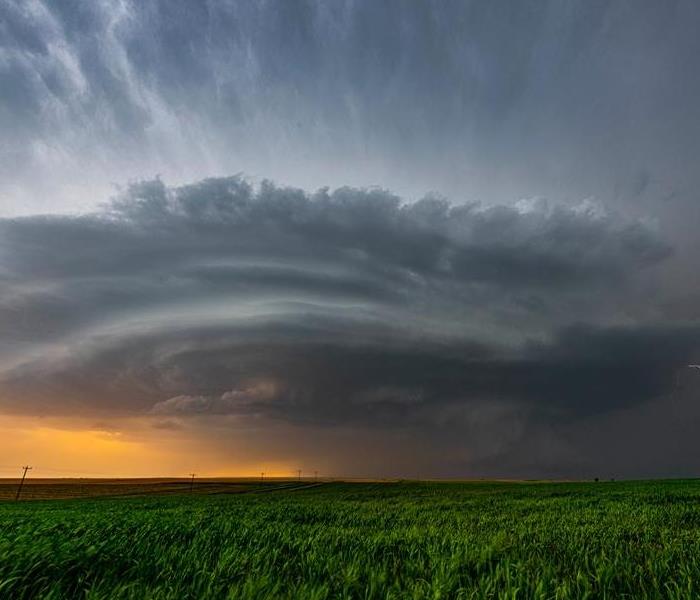 Ensure your vacation home is safe from a storm.
Ensure your vacation home is safe from a storm.
If you own a vacation home in the Northeast, you know that severe weather events are a reality that must be prepared for. From powerful coastal storms to heavy snowfall, the Northeast region experiences a wide range of weather conditions that can potentially damage your property. In this blog post, we will discuss the top strategies for storm-proofing your Northeastern vacation home, ensuring its resilience and protecting your investment.
Reinforce Doors and Windows
One of the first areas to address when storm-proofing your vacation home is the doors and windows. Strong winds can pose a significant threat to the structural integrity of your property. Install storm shutters or impact-resistant windows to protect against wind-borne debris. Reinforce entry doors with sturdy materials and install weatherstripping to keep strong winds and water out.
Before a storm hits, secure any outdoor items that could become projectiles in high winds. Patio furniture, grills, and decorative elements should be either brought indoors or securely tied down. Consider investing in heavy-duty outdoor storage containers to protect smaller items from damage. Additionally, trim trees and remove any dead branches that could potentially fall and cause damage during a storm.
Install a Backup Power Source
Power outages are common during severe weather events. Installing a backup power source, such as a generator or solar panels with battery storage, can keep essential systems running in your vacation home. This includes heating or cooling systems, essential appliances, and lighting. Ensure that your backup power source is regularly maintained and tested so that it functions when you need it most.
Proper Damage
Proper drainage is essential for preventing water damage and flooding during storms. Clear gutters and downspouts of any debris that could obstruct the flow of water. Consider installing gutter guards to prevent clogs in the first place. Check that your property's grading slopes away from the foundation to prevent water from pooling. Additionally, install a sump pump in the basement to pump out any excess water that may accumulate during heavy rainfall.
A secure and well-maintained roof is crucial in storm-proofing your vacation home. Inspect the roof regularly for loose or missing shingles and repair them promptly. Reinforce the roof structure if necessary, especially if you live in an area prone to heavy snow loads. Consider adding hurricane straps or clips to provide additional support and protection during high winds.
Create an Emergency Kit
Prepare an emergency kit that includes essential supplies, such as flashlights, batteries, a first aid kit, non-perishable food, water, and a battery-operated weather radio. Keep the kit easily accessible in case of a power outage or evacuation. Familiarize yourself with local emergency evacuation routes and make a plan in advance.
Storm-proofing your vacation home is essential for protecting your investment and ensuring the safety of your property. By reinforcing doors and windows, securing outdoor items, installing a backup power source, maintaining proper drainage, reinforcing the roof, and creating an emergency kit, you can significantly increase your vacation home's resilience to severe weather events. Prioritizing storm preparedness will give you peace of mind and help safeguard your investment for years to come.
Why a Flood Cut is Essential for Water Damage Restoration: Understanding the Benefits
6/6/2023 (Permalink)
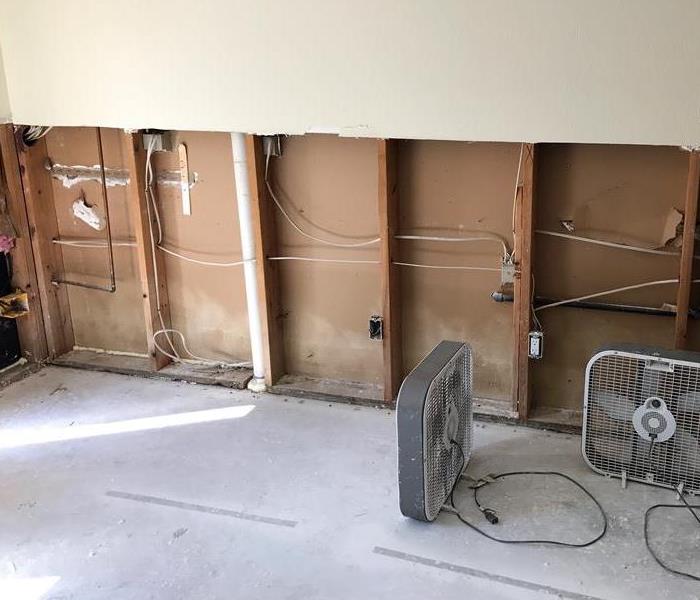 A flood cut is necessary step in the restoration process to remove water damage and prevent secondary damages.
A flood cut is necessary step in the restoration process to remove water damage and prevent secondary damages.
When a home or business experiences water damage, the cleanup and restoration process can be overwhelming. One common term you may hear during this process is a "flood cut." But what is a flood cut, and why is it necessary?
What is a Flood Cut?
A flood cut is a technique used during water damage restoration to mitigate the effects of flooding or excessive water intrusion. It involves removing a portion of drywall or other building materials above the water line to prevent further damage and facilitate drying. Typically, a flood cut is made around 12 to 24 inches above the highest water level. By removing the affected portion of the wall, professionals can access the interior space, assess the extent of the damage, and properly dry the area. This technique helps prevent the growth of mold, as it eliminates any hidden moisture that may be trapped within the wall cavity. After the flood cut is made, the damaged materials are disposed of, and the area is thoroughly dried, cleaned, and restored to its pre-damaged condition. Flood cuts are an essential part of water damage restoration, ensuring the structural integrity of the building and maintaining a healthy living environment. By removing the damaged materials, restoration professionals can properly dry and disinfect the affected area and prevent further damage.
Why is a Flood Cut Necessary?
A flood cut is necessary for several reasons:
- Preventing Mold Growth. A flood cut removes the damaged materials, preventing mold growth and reducing the risk of future water damage.
- More Effective Restoration: Removing water-damaged materials allows for more effective restoration of the affected area. Restoration professionals can properly dry and disinfect the area, ensuring that all moisture is removed and preventing further damage.
A flood cut is typically used in situations where there has been significant water damage due to flooding or excessive water intrusion. It is employed to mitigate the effects of water damage and prevent further issues such as mold growth.
A flood cut may be necessary in the following scenarios:
- Flooding: After a flood event, where a large volume of water has entered a building, a flood cut is often used to remove the affected portion of the wall and allow for proper drying and restoration.
- Burst Pipes or Plumbing Leaks: In cases where there is a significant plumbing failure, such as a burst pipe or a persistent plumbing leak, water damage can occur. A flood cut may be utilized to remove the damaged section of the wall and address the underlying issue.
- Sewage Backup: When there is a sewage backup or overflow, contaminated water can cause extensive damage to walls and pose secondary damages.
- Prolonged Water Intrusion: If water intrusion has gone unnoticed or unresolved for an extended period, leading to hidden moisture and damage within the walls, a flood cut may be necessary to expose the affected areas, assess the damage, and facilitate proper drying and restoration.
The decision to use a flood cut is typically made by water damage restoration professionals or contractors who assess the extent of the damage and the best course of action to mitigate further issues and restore the affected area.
In conclusion, a flood cut is a necessary step in the restoration process for any structure affected by water damage. It involves removing water-damaged materials to protect the health and safety of occupants, prevent mold growth, and allow for more effective restoration. If your property has experienced water damage, contact a professional restoration company to ensure that the cleanup and restoration process is done correctly and efficiently.
How To Protect Your Home From Winter Storms
7/27/2022 (Permalink)
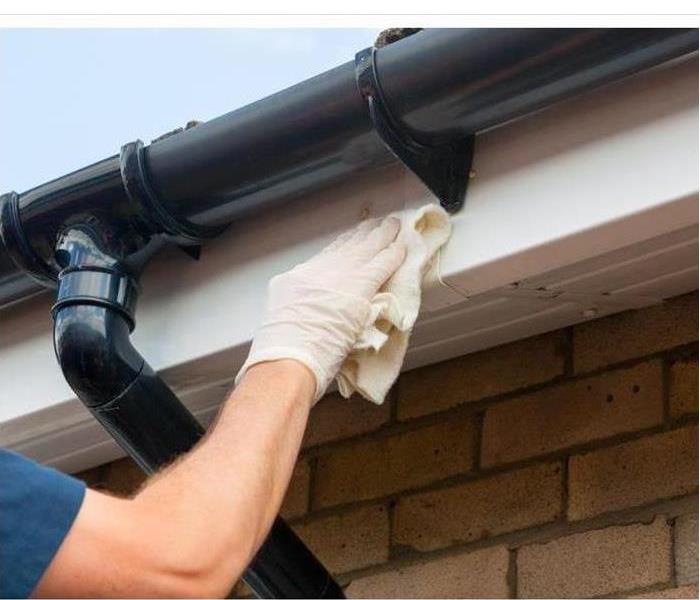 Keep your gutters clean
Keep your gutters clean
These Simple Steps Can Help Protect Your Home From Damage
It's no secret that a winter storm can wreak havoc on your home, but a few simple steps can help you protect your home from damage.
Have Supplies on Hand
When a winter storm hits, it's not always safe to go buy the things you need. That's why it's best to keep an eye on the forecast and make sure you have all the supplies you require before a storm occurs. You will need:
- Food
- Drinking water
- Snow shovel
- Flashlights and batteries
- Generator or firewood
- Warm clothing and blankets
Seal Air Leaks
Air leaks, such as extra space around doors, allow warm air to escape from your home. This will make it harder to heat your home, increasing energy costs. Seals can be applied to doors, windows, and other areas to keep the warm air in and the cold air out.
Keep Trees Trimmed
Cold temperatures and the weight of snow and ice can cause tree branches to fall. Trimming branches that could fall onto your house or vehicles can help prevent roof damage, car damage, and injury. It is also a good idea to cut off any loose or dying branches before a storm regardless of location.
Clean Gutters
Having blockage in your gutters can cause ice dams. These dams can prevent water from exiting your gutter normally and can push it under the roof, which can cause leaks and roof damage.
React Quickly
If your home incurs any damage, it is best to call an emergency restoration service immediately. You may hesitate to call if a blizzard is still ongoing, but not addressing the damage leaves your home vulnerable to additional damage.
A winter storm can be dangerous and cause damage to your home, but you can keep yourself and your house safer by having supplies on hand, sealing air leaks, trimming tree branches, cleaning gutters and reacting quickly.
What Is Involved With Roof Damage Mitigation?
6/14/2022 (Permalink)
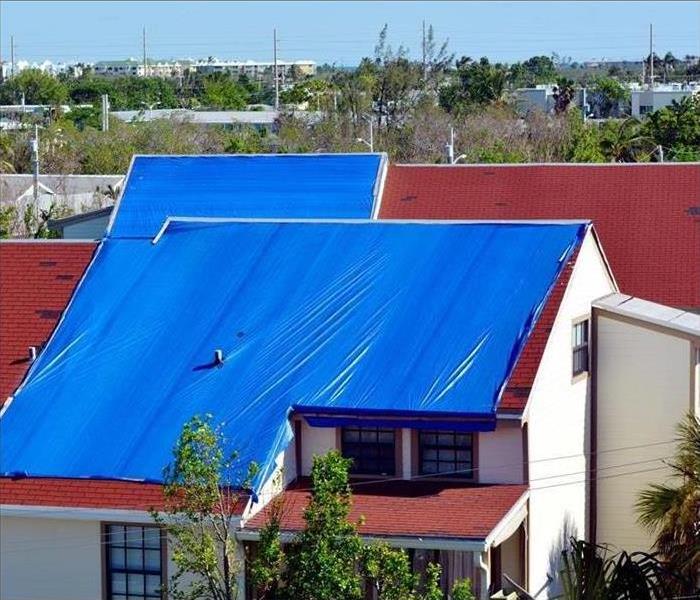 Mitigation repairs may include: tarping over the area of the roof.
Mitigation repairs may include: tarping over the area of the roof.
After a severe storm in Summerhill, PA, there is a good chance your home has sustained roof damage. When that rain and wind damage has created areas of exposure on your roof, it leaves an opening for additional damage to happen, such as mold growth. If that happens, there is a good chance that those needed repairs won’t be covered by your insurance provider.
What Does Roof Mitigation Look Like?
After filing a claim, your insurance company will likely require you to take temporary measures to mitigate damage. These mitigation repairs may include:
- Covering cracked or broken skylights and windows with plastic.
- Tarping over the area of the roof that is leaking.
- Placing a tarp over any siding that is loose or missing.
- Removing a downed branch and tarping over the damaged area.
The sooner these temporary repairs are done, the chances improve that additional damage will be avoided. If it is not possible to make these repairs yourself, certified water and mold damage companies often include tarp services.
Roof Damage Prevention
While maximizing your claim may be the most obvious reason to take mitigation measures, protecting your home is the ultimate benefit. From more bad weather to critters, any exposed areas open the door to additional damage. When that happens, it means paying out of pocket for repairs. Although you may not be able to avoid bad weather, there are ways to minimize damage to your roof. These include:
- Check the attic for signs of leaks
- Keep gutters clean
- Remove any debris on the roof
- Replace of patch missing shingles
- Trim trees nearby the home
- Get a roof inspection
When there is roof damage, it opens the door for secondary damage to happen. To avoid that and maximize your claim, take fast action to mitigate the risk and maximize your claim.
3 Safety Tips During a Thunderstorm
4/13/2022 (Permalink)
 Staying informed on the weather forecast.
Staying informed on the weather forecast.
Tips During a Thunderstorm
Any type of severe weather may pose a threat to your commercial business in Belsano, PA. Especially during a rain storm or thunderstorm, dangers like severe winds and flooding can be a cause for concern. If you own a business, it’s important to know the proper safety techniques during a storm to reduce the possibility of damage and keep yourself and your employees safe.
1. Stay Informed
Staying informed on the weather forecast and possible thunderstorm watches and warnings can be a great way to prevent any damage. Check the forecast daily and check the precipitation percentages. If there is a chance of a storm, stay up to date on the storm’s severity. It’s also important to know the difference between a watch, which means that weather conditions that may cause severe weather are expected, and a warning, which means severe weather has already been spotted by meteorologists. You can tell when a storm is coming if you see puffy cumulus clouds, darkening skies or changes in wind direction.
2. Promote Employee Safety
It’s important to be sure that your employees know what to do during a severe rain storm. Keep policies and procedures for severe weather accessible and make sure everyone knows basic safety tips, such as staying away from windows and refraining from using electric equipment. If possible, refrain from plumbing fixtures that can conduct electricity.
3. Secure Your Building
Before a storm, be sure your building is secured by removing any dead branches or other potential hazards during high winds. It’s also important to make sure any fixtures outside are either taken indoors or put in a place where they will not blow away and cause injury and damage. Make sure all windows and doors are securely shut or locked or they may blow away during the storm.
Rain storms can quickly become severe, so it’s important to be prepared. You can try to avoid damages to your commercial buildings by following these safety tips.
Avoid These 3 Causes of Sewage Backup
3/28/2022 (Permalink)
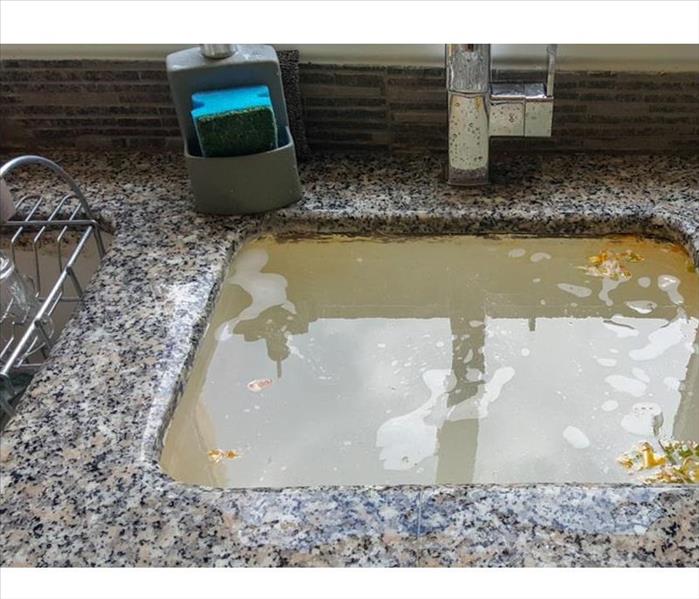 Pipes can get clogged when solid substances are thrown into sinks.
Pipes can get clogged when solid substances are thrown into sinks.
Three Possible Causes Of Sewage Backup
If you are a homeowner in Gallitzin, PA, whose house has suffered damage from a backed-up sewer, one of the biggest impact areas will likely be your basement. A flooded basement can be inconvenient and expensive to deal with, so putting in measures to prevent such an occurrence is highly advisable. Here are three possible causes of sewage backup to keep in mind.
1. Sewage Overflow
Sewage systems are designed to have a maximum water-holding capacity. Thus, when there is a heavy downpour and the amount of water coming in exceeds the capacity of a sewer, there is a high likelihood of flooding even though the system may be in perfect working condition.
2. Old Sewage Systems
The average age of many public sewage systems in the U.S. is 30 years. As a result, many of them are more susceptible to damage now than in the past. This means that if your home in Gallitzin, PA, is connected to any such public system, there is a bigger risk of suffering a flooded basement. Similarly, if you live in an older home, your plumbing may be nearing the end of its life span. Replacing old pipes and valves before they deteriorate can prevent a backup of sewage.
3. Blocked Pipes and Drains
When foreign materials get into drains and pipes, it can result in water backing up and, ultimately, flooding. Pipes can get clogged when solid substances are thrown into sinks, flushed down toilets or washed into drains from the outside. To keep your pipes and drains clear, be sure to get rid of oil and grease properly. You should also take care not to use toilets and sinks to dispose of items that do not easily degrade.
A flooded basement can cause a lot of anxiety and discomfort to a homeowner. If you find yourself surrounded by unwanted water, consider consulting a reputable water damage restoration company to help.
Assessing Flood Damage After a Rainstorm
1/4/2022 (Permalink)
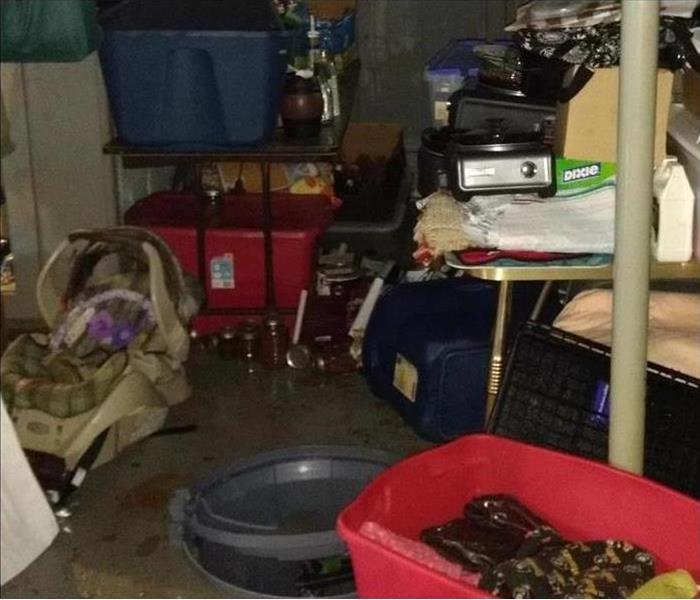 A rainstorm caused this basement to flood.
A rainstorm caused this basement to flood.
After a Rainstorm, Evaluate Flood Damage
Heavy rainstorms around Ebensburg, PA, have caused many homes to experience flooding, which can transport dangerous microorganisms into your residence. Unlike damage from a broken pipe or leaky appliance, floodwaters pick up bacteria and germs from outdoors and deposit them inside. Long after a storm has passed, leftover water and humidity linger behind in absorbent and porous materials. Determining the source of water in your home is an important step in the restoration process.
Understanding the Three Categories of Water Damage
Each water category requires a different cleaning and restoration procedure. The most important thing to determine is whether the water originated from inside or outside the residence. All damage caused by flooding from rainstorms is considered category 3.
• Category 1 and 2: Water from a source inside the home, such as a leaky pipe or appliance.
• Category 3: Water from an outside source that is brought into a residence and causes flood damage. This category can introduce a variety of contaminants into a home. Floodwaters have oftentimes been in contact with harmful elements, such as sewage, that may harbor dangerous microorganisms.
Starting the Cleaning and Restoration Process
After determining the category, the next step is contacting a qualified professional service that has the proper equipment and skills to handle water damage.
• Cleaning Category 1 or 2: Using extractors, experts should remove any water from saturated areas. Affected walls and baseboards would be removed and vent holes drilled to allow airflow. Fans and dehumidifiers should be strategically placed throughout the area to decrease humidity. Any category 2 damage would also include carpet disinfection.
• Cleaning Category 3: Contaminated areas should be isolated, and all remaining water removed. Nonabsorbent materials should be disinfected. After the decontamination, the rest of the procedure follows the same steps as a category 1 or 2 cleaning.
Dealing with flooding situations is never fun. However, with the help of qualified professionals, your home can be decontaminated and restored safely, quickly and correctly.




 24/7 Emergency Service
24/7 Emergency Service






